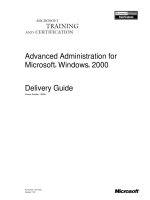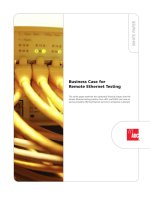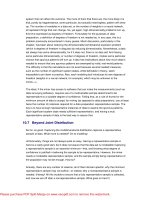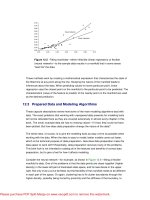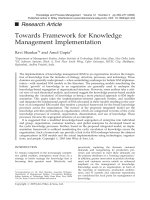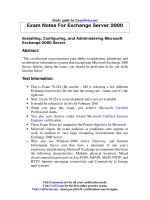Tài liệu A Case for Midspan Power-over-Ethernet Controlers ppt
Bạn đang xem bản rút gọn của tài liệu. Xem và tải ngay bản đầy đủ của tài liệu tại đây (319.62 KB, 12 trang )
A Case
for Midspan
Power-over-Ethernet
Controllers
WHITE PAPER
Introduction
The approval of the IEEE 802.3af Power over Ethernet (PoE) standard in June
2003 removed a significant barrier to the widespread adoption of IP telephony, the
expansion of WiFi networks, and the increased use of IP network cameras and
RFID scanners.
This standard allows electric power to be sent along the same cables that carry
Ethernet data. PoE-enabled switches and controllers can now deliver power over
standard Category 5e or 6 Ethernet cabling to remote PoE-enabled devices such
as IP phones, WLAN access points, security systems, and RFID scanners. PoE
simplifies the deployment of literally any IP-based device, particularly in areas
where it may be difficult or expensive to run separate power cabling.
When expanding a network using PoE, businesses face a basic choice as to how
to deliver power over Ethernet. They can rip out their existing switches and replace
them all with new PoE-enabled switches. Or they can buy a midspan controller,
which sits between an existing Ethernet switch and powered devices, and delivers
both power and Ethernet data to the devices.
This white paper examines the substantial financial impact that using ADC’s
midspan Power-over-Ethernet (PoE) controllers, rather than buying new PoE-
enabled switches, can have on your business. Investment in ADC midspan PoE
controllers yields immediate savings in purchase and installation costs, as well as
permanent and ongoing benefits due to lower support and maintenance costs,
reduced power consumption, and increased productivity due to decreased device
downtime. These benefits facilitate a rapid payback of solution costs and a high
return on investment.
A Case for
This white paper examines the substantial financial impact ADC’s
Midspan Power-over-Ethernet Controller can have on your business.
Midspan Power-over-Ethernet Controllers
A Case for Midspan Power-over-Ethernet Controllers
Page 4
The Benefits of Power-over-Ethernet
Midspan Controllers
As networks encompass a wider range of IP devices,
notably IP telephones, WiFi access points, IP-enabled
security cameras, and RFID scanners, delivering power to
devices becomes a problem.
Before PoE, these devices required separate cabling,
AC outlets, and wall warts, an extremely expensive
proposition for initial deployment. Cabling and outlets also
required ongoing support and maintenance. PoE solves
the problem by eliminating the need for AC outlet
installation, cutting maintenance and support costs, and
decreasing the cost of running power to the devices.
Businesses have invested billions of dollars in existing IP
architecture that does not adhere to PoE standards.
Therefore, they face a basic decision when deploying PoE
— should they rip out their existing Ethernet switches and
replace them with PoE-compliant switches, or instead
keep their investment in their existing infrastructure, and
add midspan controllers, such as the ADC midspan PoE
controller, which sits between an existing Ethernet switch
and powered devices and delivers power and Ethernet
data to the devices?
Figure 1 shows a typical installation using ADC’s midspan
PoE controller. 10/100Base-T data is routed via a standard
RJ45 cable from the Ethernet switch to the midspan PoE
controller. The midspan PoE controller injects power into
the unused pairs if a PoE-compliant device is detected on
the remote end. Appropriate cable management and
installation practices should be used to route these cables,
because critical voice and data traffic is being transmitted
over the Ethernet cables.
ADC midspan PoE controllers offer significant financial
benefits when compared to replacing or upgrading
existing Ethernet switches and replacing them with new
PoE-compliant switches:
• They cost less than new PoE switches, and can be
installed more easily and at less cost.
• They offer increased productivity because of greater
device uptime.
• They require less support and maintenance.
• They require less power.
• They offer easier upgrade options.
• They offer increased flexibility, and have the capability
of only enabling nodes that require power.
• They include an optional SNMP module that enables
software management and complies with RFC 3621.
• The chassis can be daisy-chained — up to five chassis
can be controlled with one SNMP card and one
IP address.
UPS
Power over Ethernet
Midspan Controller
VoIP Phone Wireless LAN
Access Point
Network
Camera
Ethernet
Switch
Figure 1:
ADC’s Midspan Power-over-Ethernet Controller
ADC midspan PoE controllers offer significant
financial benefits when compared to
replacing existing Ethernet switches with new
PoE-compliant switches. For all sized
businesses, they yield immediate savings in
purchase, installation and configuration costs.
A Case for Midspan Power-over-Ethernet Controllers
Page 5
The Business Case for ADC’s Midspan
Power-over-Ethernet Controllers
ROI Study Methodology
ADC collaborated with an independent research organ-
ization that specializes in ROI and cost benefit analysis to
perform an objective analysis of the financial benefits
generated by the deployment of ADC’s midspan PoE
controllers compared to buying new PoE Ethernet
switches. The study evaluated three typical scenarios: a
small remote office of 50 users, a medium-sized business
with 500 users, and a large enterprise with 5,000 users at
five different sites.
The study analyzed each area of savings offered by use of
the device, and considered such factors as:
• Purchase price of the midspan controllers
• Purchase price of new PoE-enabled switches
• Installation costs
• Ongoing maintenance and support costs
• Ongoing management costs
• Productivity gains due to increased availability
• Power consumption
• Downtime of IP devices when using PoE-enabled
switches versus midspan controllers
The results were calculated and then extrapolated for
subsequent years for a five-year analysis period. While
results will vary with each customer scenario, these cases
are representative of high-growth environments.
Companies of different sizes and with heavier use of their
networks may experience greater benefits. (Results shown
are not a guarantee of equivalent performance.)
Contributing to these results are lower acquisition and
installation costs; lower support, maintenance, and power
costs; and increased user productivity due to the increased
availability of IP devices when compared to buying new
PoE-enabled Ethernet switches.
Financial Analysis
Table 1 on the following page contains the input data used
in our analysis.
Table 2 summarizes the value created by the ADC solution
on a cumulative basis for the three different business
scenarios. (More details about each scenario can be found
later in this white paper.) Startup costs are separated from
recurring costs, with one-time solution deployment
expenses categorized as startup costs. All expenses
incurred after the solution is placed into production are
listed in the recurring costs. The analysis uses the classic
definition of payback period. The calculation involves a
comparison of the net benefit generated by using ADC
Midspan PoE Controllers versus the investment, fully
reflected in the startup costs.
ROI Highlights
Small office (50 remote users)
• Immediate savings from lower acquisition and
installation costs: over $8,000
• Total benefits over the five-year study timeframe:
over $45,000
• Payback of the startup investment: Less than
three months
• Annual benefit per employee: $183
• Five-year ROI: 337%
Medium Office (500 users)
• Immediate savings from lower acquisition and
installation costs: Over $57,000
• Total benefits over the five-year study timeframe:
over $202,000
• Payback of the startup investment: six months
• Annual benefit per employee: $81
• Five-year ROI: 97%
Large Office (5,000 users at five offices)
• Immediate savings from lower acquisition and
installation costs: over $1.1 million
• Total benefits over the five-year study timeframe:
over $2.3 million
• Payback of the startup investment: five and a
half months
• Annual benefit per employee: $93
• Five-year ROI: 115%
